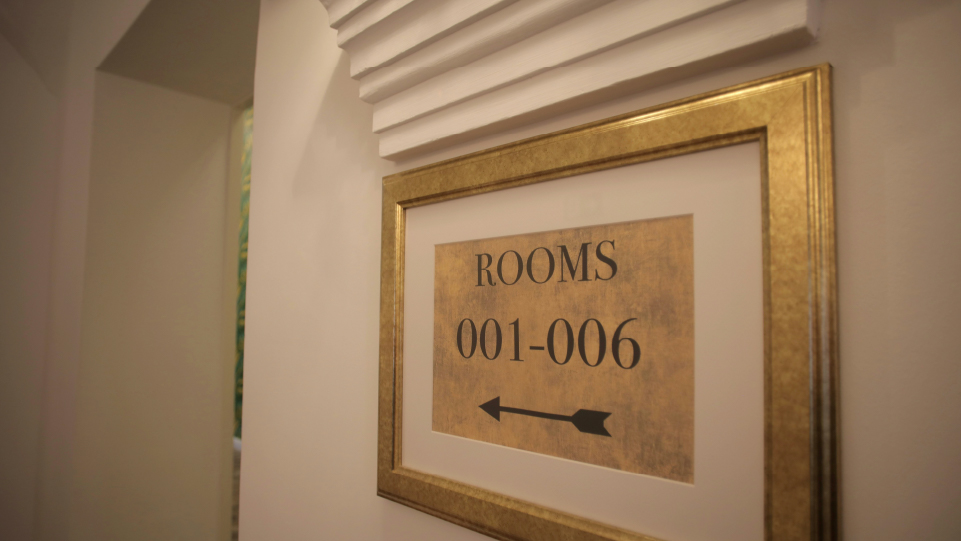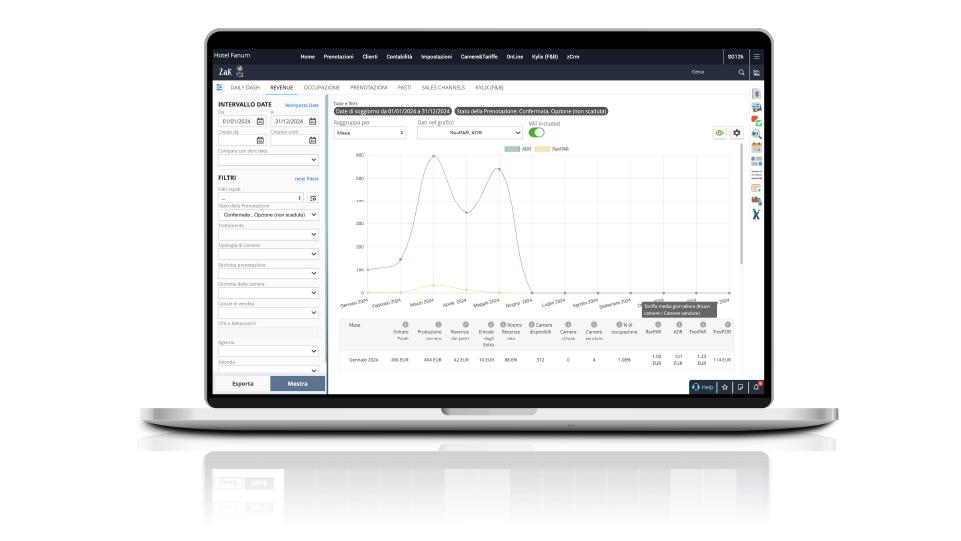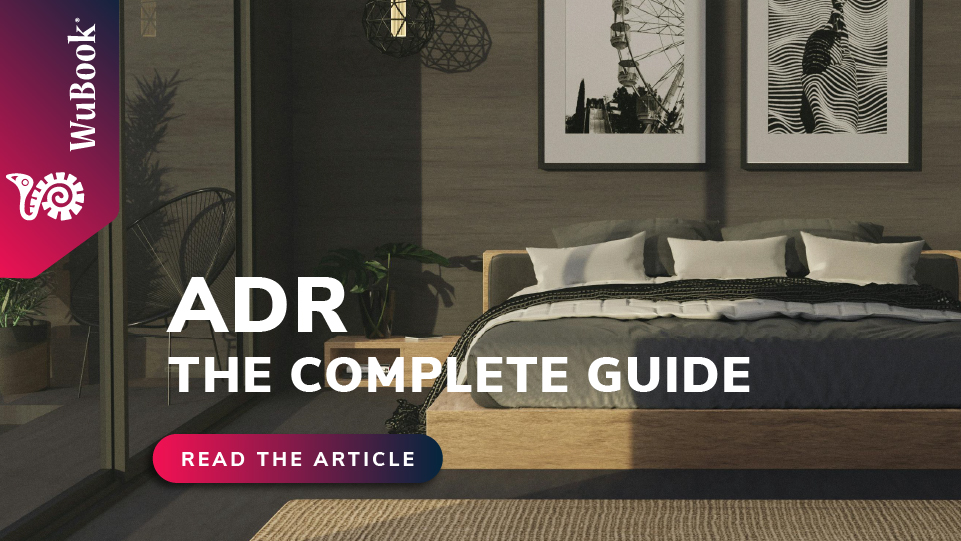Dear WuBookers, there is no shortage of acronyms in the hotel industry, and today we are looking at one of the most important acronyms for properties: the ADR. This performance index is essential to understand, along with the others, the performance of the hotel (or B&B or vacation rental) and make any changes to the sales strategy. So let’s see what it is and how to increase it.
ADR: what it means and how it is calculated
ADR is short for Average Daily Rate. And that is exactly what ADR returns: the average price paid by guests per day (or per night, to be more precise) over a certain period of time.
The ADR formula is very simple: just divide the revenue earned from the sale of rooms by the number of rooms sold (understood as the number of occupied nights).
Let’s take an example: in one month, a hotel sold 200 rooms (the sum of all occupied nights for each room sold) and made 30 thousand euros. Its ADR will be equal to: 30.000 € / 200 = 150 €. This means that, on average, a customer spent €150 to stay in the facility one night.f course, the same calculation can be done in an overall way, as just seen, or by individual room types, by sales channel, or by customer segment.
The important thing is to try not to make mistakes that could incorrectly affect subsequent evaluations.

3 common errors in ADR calculation
One of the most common errors that occur when measuring ADR concerns precisely the rooms factor. Indeed, there is often a tendency to include all available rooms and not just those actually sold. Or, on the other hand, not to exclude those occupied for service reasons, perhaps because they are employed by the Staff or the property, or offered as gifts to guests.
However, this risks compromising the final result and giving an untrue overview of the average daily rate.
The second error, on the other hand, concerns income: what to include in this entry? How to consider earnings from, for example, extra services? In this case, it is important to remain consistent over time and define what is most important to us. If the figure we are interested in is the “pure” figure of the average sales rate alone, then we should not consider anything else, and we should keep this same criteria for the future as well, to avoid comparing incongruent values with each other.
Another aspect relates to net revenues, that is, what is left in cash after paying any commission costs associated with, for example, distribution channels: net ADR differs from classical ADR precisely in this respect.
But why is ADR important and what is it used for?
What is the purpose of ADR?
ADR is one of the most important performance indicators (Key Performance Indicator, or KPI) for the hotel industry along with occupancy rate (%OCC) and RevPar (Revenue Per Available Room).
Considered alone, it is in fact not sufficient to give an accurate picture of the hotel’s situation and should still be related to at least the other two.
However, ADR helps to understand what the external perception of the hotel is and whether the communication and marketing activities put in place are effective.
In addition, ADR is often used to compare one’s property to other similar properties (an operation that obviously does not take into account net ADR and can be done with the help of Revenue Management software).
So, in general, there is no one positive value that applies to all properties, but the specific context and trends in sales and availability over time must be considered, including with respect to seasonality and elasticity of demand.
Let’s put all the above together and assume that a hotel has a high ADR compared to its competitors. On paper, this could be a good result, but a lot also depends on the occupancy rate: if it has sold only a few rooms compared to those available, the overall performance may not necessarily be optimal, even if the sales rates are high.
On the other hand, a low ADR with 100 percent occupancy might still be sufficient for business sustainability but indicate an image problem, whereby customers are willing to pay less for your services than other properties.
In essence, ADR allows you to make informed decisions that affect your positioning and sales strategy to maximize revenue and optimize investment.
How to increase the hotel’s ADR
Raising rates is not enough to increase ADR! Higher prices could in fact lead to a significant reduction in reservations, resulting in a negative revenue balance at the end of the period.
In fact, as we mentioned, much depends on the perceived quality of the property by potential customers, and that is why this is where we recommend you start to improve ADR.
1. Work on brand reputation and marketing
To encourage customers to book at your property, perhaps by paying a higher price than others, you need to convince them that their money is well spent. Nurturing your hotel’s reputation by presenting services well and managing reviews can affect demand and, therefore, encourage reservations at higher rates.
If you then decide to present yourself as a premium property, then this operation will have to be even more widespread and you will have to make sure that every channel and communication tool matches the image you want to convey (thus justifying the increased sales prices).

2. Decide your offer on each individual target
To increase perceived value, you need each target audience to find what they need. So the first step is to know what your target audiences are (leisure tourists, business tourists, and so on) and tailor messages – and offers – to each one. Or even property dedicated vacation packages.
During this process of segmentation, you may also find that you have a portion of loyal customers who return regularly. A particularly valuable type because they are already convinced, acquired, and tend to be less price-sensitive: a contingency to be used to your advantage!
3. Reduce intermediary costs
If you decide to look at net ADR, you will have to subtract the cost of brokerage from the sale. A cost that probably affected ( upwards ) your rate as well. What does all this mean? That there is a portion of your revenue that you could turn into profit by incentivizing direct reservations.
Not only that, by eliminating commission costs, you can have more leeway to decide on your fee schedule without any constraints whatsoever.
4. Propose upsells and manage cancellation conditions
Another way to increase ADR is to offer a reservation upgrade to upcoming or existing guests. Of course, for the proposition to be truly palatable, there must be a tangible benefit: it is not enough to provide a larger room, but any extra services or exclusive experiences must be matched, justifying the extra charge. This is also a good way to drive up the value of sales without affecting the public rate, because it is extemporaneous and confidential.
Still on the subject of rates, don’t forget that these can vary depending on the cancellation policies you decide to set: usually flexible ones have higher sales charges than non-refundable ones; but you can also set a minimum stay period to ensure a certain occupancy rate.
The desirability of each strategy depends on many factors and can positively affect ADR.
Calculate and manage ADR using a PMS.
We have seen what it is, how it is calculated and how to increase it. But in daily life, when there are so many things to manage, how can you keep track of ADR without having to do complex manual operations? For example, through your PMS.

Zak, WuBook’s software for hotels, B&Bs and vacation rentals, already provides within it the measurement of several essential parameters, such as: available rooms, rooms sold, rooms closed, total revenue, room revenue, % occupancy, RevPAR, TrevPAR (Total Revenue Per Available Room), TrevPOR (Total Revenue Per Occupied Room), % occupancy, RevPOB (Revenue Per Occupied Bed), RevPAB (Revenue Per Available Bed). And, of course, ADR.
In this way, the hotelier can get the general overview as well as the particular one: the ADR does indeed take into account the revenue of the overnight stay only (without considering either breakfast or other meals or ancillary services). But he can derive the overall figure through the TrevPAR and TrevPOR, which are instead calculated starting from the Total Revenue, that is, the total reservation revenue related to rooms, extras and meals (including OTA commissions, excluding tourist tax).
Zak by WuBook also allows:
- To filter ADR by various channel types, distinguishing between manually entered reservations, reservations from the booking engine, reservations from the channel manager (and here you can filter further by choosing the OTA of interest);
- To set a personalized time frame and compare it with another period of your choice;
- To also display the ADR for a future period (the figure is based on confirmed reservations at the time of reading) to compare with the past period and make rate changes if necessary;
Integrate its functionality with that of the best-known Revenue Management Systems (RMS), to achieve an even more comprehensive and powerful revenue control tool-and dynamic rate management.
ADR alone is not enough to get a complete picture, but neglecting it means excluding an important indicator of the performance and effectiveness of the activities performed-a good PMS can help you check and govern this aspect as well.
